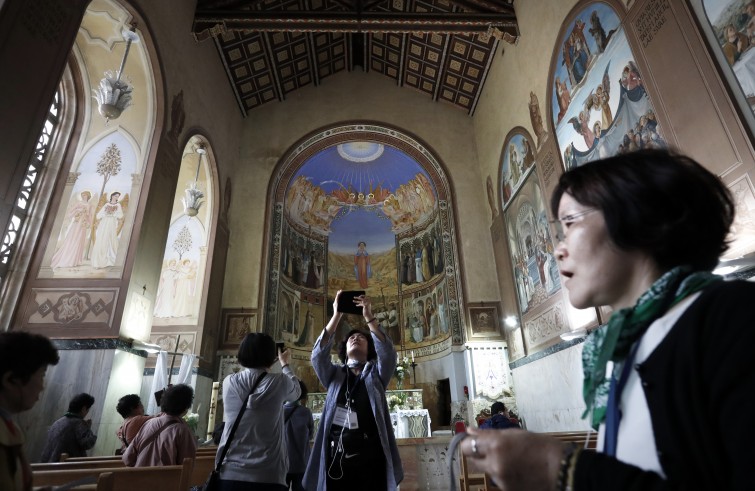
At a close glance, FBO statistics regarding the period October-December 2014 – the ones first available since the adoption of the new digital system – show that the first 6 countries in a ranking of 20 Countries with the highest number of pilgrims, are Asian. In the year of the Gaza war, Indonesia was the fourth Country with 6519 pilgrims divided into 188 groups; India ranked eighth with 3363 in 59 groups; the Philippines was twelfth with 1683 and 35 groups; Malaysia was fourteenth with 1019 in 25 groups; Singapore was sixteenth with 708 pilgrims in 15 groups; China was twentieth with 641 pilgrims in 19 groups. Below the first twenty, figures Hong Kong (24) with 499 pilgrims, Sri Lanka (26) with 454, South Korea (38) with 254. Further behind are ranked Taiwan, Japan, Viet Nam and 76 “exile pilgrims” from North Korea (62).
The total calculation of the final quarter of 2014 shows that Asia, after Europe, is the continent of origin of most pilgrims with 16,297 presences in 423 groups, slightly more than North America (16256) and Latin America (12866).
Africa and Oceania rank last in this particular classification of “Pilgrim Continents.”
2015. This performance improved in 2015, when the booking system went fully operational, providing data referring to all 12 months. Asia was confirmed second behind Europe, with 59,668 pilgrims in 1729 groups, clearly distant from North America (53110). As many as 7 Asian Countries figured among the top 20 countries with the highest number of pilgrims. Indonesia was fourth with 19.922 presences in 631 groups, India reached a seventh place with 13,572 presences in 298 groups, stable the Philippines (12) with 5854 presences in 174 groups. South Korea registered a leap ahead: from the 38th to the 13th place with 4095 presences in 155 groups, China went from 20th to 14th on the list, with 3396 pilgrims in 90 groups, Sri Lanka from 26th to 17th with 2 640 pilgrims in 57 groups. Singapore is the only Country that fell 18th, with 2397 pilgrims in 67 groups. Further behind figure Malaysia (27), Hong Kong (38), Taiwan (50) and North Korea (66). At the bottom of the list are ranked Myanmar with 65 pilgrims in three groups, and Thailand, with a group of 30 pilgrims.
2016, a slight recovery. “The first three months of 2016, when compared to last year, show signs of recovery, albeit these signs are rather small – said Fr Agustin Pelayo Fregoso, director of the Christian Information Center, within which operates the FPO – these months traditionally register low inflows of pilgrims, January and February in particular, nonetheless we registered an increase. Moreover, in 2016 Easter was celebrated at the end of March, and this brought more pilgrims. Now we hope the upward trend will continue also in the coming months.” To date, (March 2016), figures show there has been a total of 61871 pilgrims, a slight increase compared to the same period in the previous year, 24488 of whom arrived from Asian Countries. Three of these Countries rank among the top ten: Indonesia (4) India (5) and South Korea (8).
A pleasant challenge. The friars of the Custody see the presence of such high numbers of Asian pilgrims as a “pleasant challenge”. “When they arrive in pilgrimage they are responding to the many appeals from the Holy Land”, said Fr Fregoso. Welcoming them and assisting them isn’t always an easy job. In many cases the groups don’t have a priest accompanying them and therefore the presence of priests that celebrate Mass and confess them in their local language is indispensable.
They face long, expensive journeys in order to arrive here. They are not afraid and have no fears for their safety. We have the duty to welcome them in the best way.
Friars who speak Indonesian, Chinese, Malaysian, Japanese, Vietnamese, Indian, just to give a few examples, are not easy to find, and for this reason they must undergo specific formation. Moreover, Indonesia is the largest Muslim Country in the world, and having Indonesian brothers here is a significant sign of dialogue and coexistence.”
What about Europeans? We hope that increasing numbers of Asian pilgrims will act as a drive for European ones, who, conversely, “are lagging behind.” However, there are positive signs: in 2015 the largest number of pilgrims, after the US, were the Poles, as many as 29.819, more than Italians (27,564) that registered a 40% decrease. In addition to Italians, in 2015 decreases were registered among French, Spanish and English pilgrims. Slight increases have been registered in the number of pilgrims from Germany. However, figures on European pilgrims are marked by “fears linked to wars in the area (Iraq and Syria) and by insecurity related to acts violence among Israelis and Palestinians”, concluded the FPO director, who launched yet another appeal:
“Come to the Holy Land! You will give confidence to local Christians who do not feel abandoned by the Church. Also Christians live of pilgrimages. Pilgrimages feed them and also support efforts in dialogue and coexistence, as the Muslim community also enjoys the beneficial effects of the pilgrimages.”










